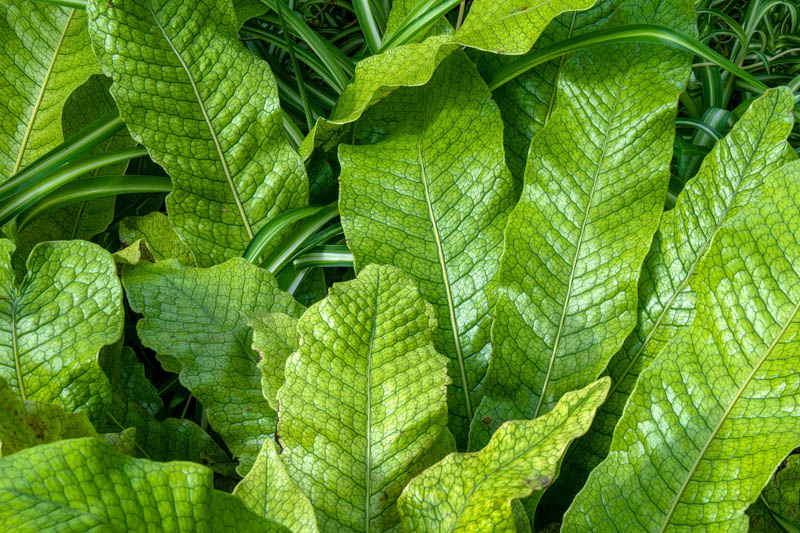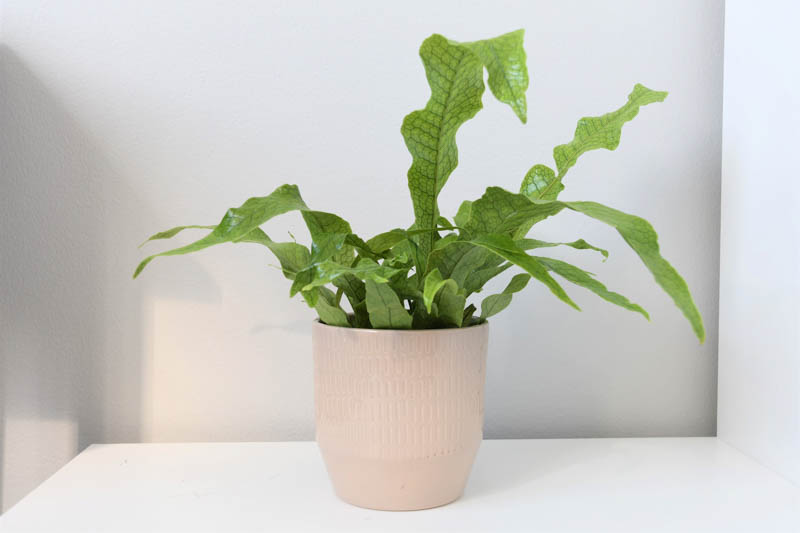Crocodile Fern, Alligator Fern
Microsorum musifolium, also known as Crocodile Fern, stands out for its unique, reptilian-textured leaves. This epiphytic fern is prized for its lush, green foliage that adds a tropical touch to any setting.
Native: The Crocodile Fern originates from the rainforests of the Malaysian Archipelago, thriving in the warm, humid conditions under the forest canopy. It belongs to the fern family (Polypodiaceae), which includes the Resurrection fern, Staghorn fern, and Blue Star fern.
Plant Type and Habit: As an epiphytic fern, it naturally grows on other trees rather than directly in the soil, using them for support while obtaining moisture and nutrients from the air and rain.
Size: It typically reaches up to 2-3 feet (60-90 cm) in both height and spread, making it an impressive specimen for indoor gardens.
Foliage: Its leaves are its standout feature, with a glossy green surface and a texture reminiscent of crocodile skin. The upright to arching, leathery fronds are elongated and can grow quite large, making them visually striking. Sori appear on the undersides along the veins.
Hardiness: It is hardy in USDA zones 10-11. In cooler climates, it’s commonly grown indoors or as a greenhouse specimen.
Uses: Ideal for indoor decoration, terrariums, or shaded tropical gardens. Its unique texture makes it a popular choice for adding visual interest to houseplant collections.
Toxicity: Microsorum musifolium is not known to be toxic to cats, dogs, or humans, making it a safe choice for households with animals and children.
Benefits: Besides its aesthetic appeal, it can improve indoor air quality and add to the humidity of its surroundings, beneficial in drier climates or during winter months in temperate regions.

Growing Crocodile Fern successfully both indoors and outdoors involves creating conditions that mimic its natural, tropical habitat. Here’s how to care for this unique fern in different environments:
Light: Place it in bright, indirect light. Avoid direct sunlight, which can scorch its leaves. An east–facing or west–facing or south–facing window or a spot that receives filtered light through sheer curtains is ideal.
Soil: Use a well-draining, rich organic potting mix. A mix designed for orchids or epiphytes works well, as it allows for good air circulation around the roots.
Water: Keep the soil consistently moist but not waterlogged. Water when the top inch of soil feels dry to the touch. Use lukewarm water to avoid shocking the plant.
Humidity: Crocodile Fern thrives in high humidity. Increase humidity by placing the pot on a pebble tray filled with water, misting the plant regularly, or using a humidifier.
Temperature: Maintain indoor temperatures between 60-75°F (16-24°C). Avoid cold drafts and sudden temperature changes.
Fertilizer: Feed with a balanced, water-soluble fertilizer diluted to half strength once a month during the growing season (spring and summer). Do not fertilize in winter.
Repotting: Repot every 2-3 years or when the plant becomes root-bound. Choose a pot only slightly larger than the current one to avoid overwatering.
Climate: Crocodile Fern can be grown outdoors year-round in USDA zones 10-11. In cooler climates, consider it a seasonal outdoor plant or move it indoors for the winter.
Light: Provide dappled or partial shade. Avoid direct afternoon sun to prevent leaf burn.
Water: Outdoors, it may require more frequent watering to maintain consistent soil moisture, especially in dry conditions.
Humidity: In naturally humid climates, Crocodile Fern will thrive. In drier areas, misting the plant can help increase local humidity.
Soil: Plant in rich, well-draining soil. If grown in containers outdoors, ensure there are adequate drainage holes.
Temperature: It prefers warmer temperatures and should not be exposed to temperatures below 50°F (10°C).
Fertilizer: Just like indoors, use a diluted, balanced fertilizer during the growing season.

Propagating Crocodile Fern can be a rewarding process, allowing you to multiply your plants and share them with others. The most effective method for propagating Crocodile Fern is through division. Here’s how to do it:
Timing: The best time to propagate Crocodile Fern through division is in the spring or early summer when the plant is entering a period of active growth. This gives the new divisions plenty of time to establish themselves before the slower growth of winter.
Preparing: Before starting, ensure you have a sharp, clean knife or scissors, pots filled with suitable potting mix, and water.
Removing the Plant: Gently remove the Crocodile Fern from its pot. Carefully brush away the soil from the roots so you can clearly see the natural divisions of the plant.
Dividing the Plant: Identify sections of the fern that can be separated, ensuring each division has several fronds and a healthy root system. Use the knife or scissors to cut through the roots, dividing the plant into smaller sections. Be as gentle as possible to minimize root damage.
Potting Up: Plant each division in its own pot filled with a well-draining, rich organic potting mix suitable for ferns. Water each new plant thoroughly after potting to settle the soil around the roots and remove air pockets.
Aftercare: Place the new plants in a location that mimics the parent plant’s environment—bright, indirect light with high humidity. Keep the soil consistently moist but not waterlogged. You can increase humidity by placing the pots on a pebble tray filled with water or by regularly misting the plants.
Growth: It may take some time for the divisions to recover from the shock of being divided and transplanted. Be patient and continue to provide appropriate care. With time, each division will begin to produce new growth and establish itself as an independent plant.
Crocodile Fern, despite being relatively easy to care for, may encounter certain pests, diseases, and common issues.
Spider Mites: These are tiny pests that thrive in dry conditions, causing yellowing leaves and fine webbing. Increase humidity around the plant, rinse leaves with water, or use miticides if necessary.
Mealybugs: These white, cottony pests tend to cluster in leaf axils and under leaves, sucking sap and weakening the plant. Remove with alcohol-dipped cotton swabs or apply neem oil.
Scale insects: Small, brown, dome-shaped pests that attach to the leaves and stems, sucking sap and weakening the plant. Manually remove them or treat the plant with insecticidal soap.
Root rot: Overwatering is a primary cause, leading to mushy roots and wilted leaves. Ensure proper drainage and let the topsoil dry slightly between waterings.
Leaf spot: Fungal or bacterial infections can cause brown or black spots on leaves. Improve air circulation, reduce leaf wetness, and remove affected foliage. Fungicide or bactericide treatments might be necessary for severe cases.
Brown Leaf Edges: Could indicate low humidity or watering with hard water. Increase humidity levels and use filtered or rainwater for irrigation.
Yellowing Leaves: Overwatering, poor drainage, or nutrient deficiency can lead to yellow leaves. Adjust watering habits and ensure the potting mix is well-draining. A balanced fertilizer can address nutrient issues.
Slow Growth or Lack of Foliage Density: Often a result of insufficient light. While Crocodile Fern tolerates low light, brighter indirect light will promote more vigorous growth.
| Hardiness |
10 - 11 |
|---|---|
| Plant Type | Houseplants, Ferns |
| Plant Family | Polypodiaceae |
| Exposure | Partial Sun |
| Season of Interest |
Spring (Early, Mid, Late) Summer (Early, Mid, Late) Fall Winter |
| Height |
2' - 3' (60cm - 90cm) |
| Spread |
2' - 3' (60cm - 90cm) |
| Spacing |
24" - 36" (60cm - 90cm) |
| Maintenance | Low |
| Water Needs | Average |
| Soil Type | Loam, Sand |
| Soil pH | Acid, Neutral |
| Soil Drainage | Well-Drained |
| Characteristics | Showy, Evergreen |
| Tolerance | Full Shade |
| Garden Uses | Beds And Borders, Patio And Containers |
| Hardiness |
10 - 11 |
|---|---|
| Plant Type | Houseplants, Ferns |
| Plant Family | Polypodiaceae |
| Exposure | Partial Sun |
| Season of Interest |
Spring (Early, Mid, Late) Summer (Early, Mid, Late) Fall Winter |
| Height |
2' - 3' (60cm - 90cm) |
| Spread |
2' - 3' (60cm - 90cm) |
| Spacing |
24" - 36" (60cm - 90cm) |
| Maintenance | Low |
| Water Needs | Average |
| Soil Type | Loam, Sand |
| Soil pH | Acid, Neutral |
| Soil Drainage | Well-Drained |
| Characteristics | Showy, Evergreen |
| Tolerance | Full Shade |
| Garden Uses | Beds And Borders, Patio And Containers |
How many Microsorum musifolium (Crocodile Fern) do I need for my garden?
| Plant | Quantity | |
|---|---|---|
| Microsorum musifolium (Crocodile Fern) | N/A | Buy Plants |
Create a membership account to save your garden designs and to view them on any device.
Becoming a contributing member of Gardenia is easy and can be done in just a few minutes. If you provide us with your name, email address and the payment of a modest $25 annual membership fee, you will become a full member, enabling you to design and save up to 25 of your garden design ideas.
Join now and start creating your dream garden!
Create a membership account to save your garden designs and to view them on any device.
Becoming a contributing member of Gardenia is easy and can be done in just a few minutes. If you provide us with your name, email address and the payment of a modest $25 annual membership fee, you will become a full member, enabling you to design and save up to 25 of your garden design ideas.
Join now and start creating your dream garden!